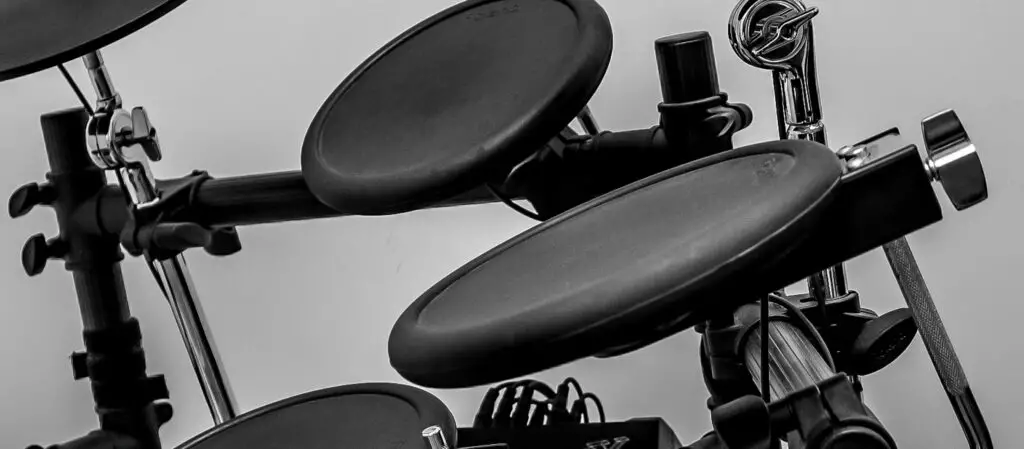Electronic drum kits are often preferred for home-use because they are much quieter compared to acoustic drum kits, but how loud actually are they?
The Quick Answer
Electronic drum kits are quieter compared to acoustic drum kits but will still be heard by neighbours in adjoining rooms or if they are on the level below. The volume of most electronic drum kits is approximately 60-65 dB when not plugged in.
There are several ways to reduce the volume of an electronic drum kit to avoid the neighbours from hearing including using noise isolation flooring, beaterless kick pedals and drumstick silencers.

How Loud are the Different Kit Components?
Electronic drum kits have three main components:
- Snare and tom pads
- Kick pedal/ pad
- Cymbal pads
These components create different levels of ambient noise when struck with the drumsticks so let’s take a look at them individually.
Snare and Tom Pads
There are two materials which can be used to make the pads: rubber and mesh.
Rubber pads are much harder so the sound of the stick striking them is louder. Mesh heads on the other hand have tonnes of tiny holes in them which diffuse the sound and make them quieter. Hence, if you’re concerned with the ambient volume of your kit then definitely go with mesh heads.
In either case you will be able to hear a noise if you are in an adjoining room or in a room below the kit but the sound of the snare and tom pads should not cause a big issue if both doors are shut. The sound will be roughly the same level as someone talking loudly but not shouting.
Check out my article comparing mesh and rubber drum pads to learn more about the pros and cons of each material.
Kick Pad/ Pedal
The kick pad/ pedal is the loudest part of the drum kit to neighbours underneath.
When the beater kits the kick pad it will make a sound that can be heard reasonably loudly. This will usually transfer into an adjoining room but it’s the floor underneath that you’ll need to worry more about.
Since the foot pedal and pad are in contact with the ground, the sound will be much louder underneath the room. On average this sound can be around 60 dB in the room below. For comparison, 60 dB sounds as loud as two people having a normal level conversation sat a meter away.
This can be a real issue if you live in an apartment and have neighbours underneath you.
To combat this you can put the pedal on a platform (more on this later) which helps to prevent the sound from transferring to the ground.
Alternatively, you can use an electronic drum kit which doesn’t have a beater and instead just has a pedal. Granted this makes it feel less like a “real” drum kit, but it will reduce the noise significantly.
Cymbal Pads
The cymbal pads on pretty much every electronic drum kit are made from rubber. This means they are louder compared to mesh drum pads, but since they are located furthest from the ground, the sound doesn’t transfer as much into the floor.
Hence, you shouldn’t really have an issue with your cymbal pads causing too much noise to bother the neighbours unless the walls are very thin.
Summary of the Components
To summarise, the kick pedal and pad are the loudest part of an electronic drum kit (unless you are using a kit which doesn’t have a beater pedal). The snare, toms and cymbals pads are quieter and unlikely to cause an issue with neighbours. If you want to reduce the ambient volume, opt for mesh heads instead of rubber pads.

Practicalities of Electronic Drum Kit Noise
Playing an electronic drum kit on the ground floor with no neighbours or household members underneath is unlikely to cause much annoyance. The sound of the pedals and pads will leak into the adjoining rooms slightly but this shouldn’t cause a huge issue in most cases and can be combatted by using stick silencers.
However, if you are using an electronic drum kit on any other floor other than the ground floor then your neighbours/ household members underneath you will hear it if you’re using a beater pedal for your kick drum. This could potentially lead to noise complaints as it can get quite loud.
Tips to Make an Electronic Drum Kit Quieter
Fortunately, there are several things you can do to make sure you can play an electronic drum kit quieter so you can use it an an apartment without annoying your neighbours.
The best way to make an electronic drum kit quieter is to use noise isolation flooring to prevent the sound transferring into the floor underneath it. Another solution is to use a beaterless kick pedal. Other options to reduce the noise include using drumstick silencer tips and mesh drum heads.
Use Drumstick Silencer Tips
To reduce the volume of the noise when the sticks hit the pads, you can use silencer tips which make them softer. This is a really cheap and easy option and will make some difference, however it’s likely you’ll also need to use some other methods on this list too.
Check out these drumstick silencer tips on Amazon.
Image links to Amazon
Use Mesh Drum Heads
Mesh drum heads are much quieter compared to rubber drum pads. Most electronic drum kits have rubber kick pads, but there are some which have mesh pads such as the Alesis Surge Mesh. This is a good option to reduce the volume of your kick pad.
Use a Beaterless Kick Pedal
Some drum kits have kick pedals with beaters which are more realistic, and others have beaterless kick pedals which means you only have to press the pedal to produce the sound.
Beaterless kick pedals are much quieter compared to standard beater kick pedals so are a great option if you live in an apartment and need to reduce the amount of sound transfer into the ceiling below.
An example of an electronic drum kit with beaterless kick pedals is the Alesis Turbo Mesh. You can also use the Roland KT-9 pedal which reduces the noise in the room below by 63%.
Check out the Roland KT-9 on Amazon.
Image links to Amazon
Choose a Softer Beater
Opting for a softer beater can be a decent option to help reduce the volume of the kick pad. However, it doesn’t make a massive improvement so it can only really be used to help reduce the problem in addition to some other options on this list, rather than fix the issue on its own.
Noise Isolation Flooring
This is the best way to reduce the amount of noise your drum kit makes in the room underneath it making it the ideal solution if you want to play an electronic drum kit in an apartment.
There are two options here:
- Noise Eaters
- DIY Noise Isolation Flooring
Both these options use the same principle. They both raise the drum kit off the ground so the noise doesn’t transfer into the floor underneath.
Roland Noise Eaters are a great option which don’t take up much space because they simply go underneath the kick pedal (the biggest culprit for excessive noise). However, they are quite expensive.
Check out this link to the Roland Noise Eater NE-10 on Amazon.
Image links to Amazon
Instead you can use two sheets of MDF separated by tennis balls to make your own noise isolation flooring! Check out this YouTube video to learn more.
Compared to Acoustic Drum Kits?
Electronic drum kits are significantly quieter compared to acoustic drum kits. Acoustic drum kits can reach 130 dB whereas electronic drum kits typically do not exceed 70 dB. Hence, many drummers like to use an electronic drum kit at home to avoid upsetting the neighbours, and then use an acoustic drum kit at a venue or recording/ practicing studio.
Here are some more articles you might find useful:




